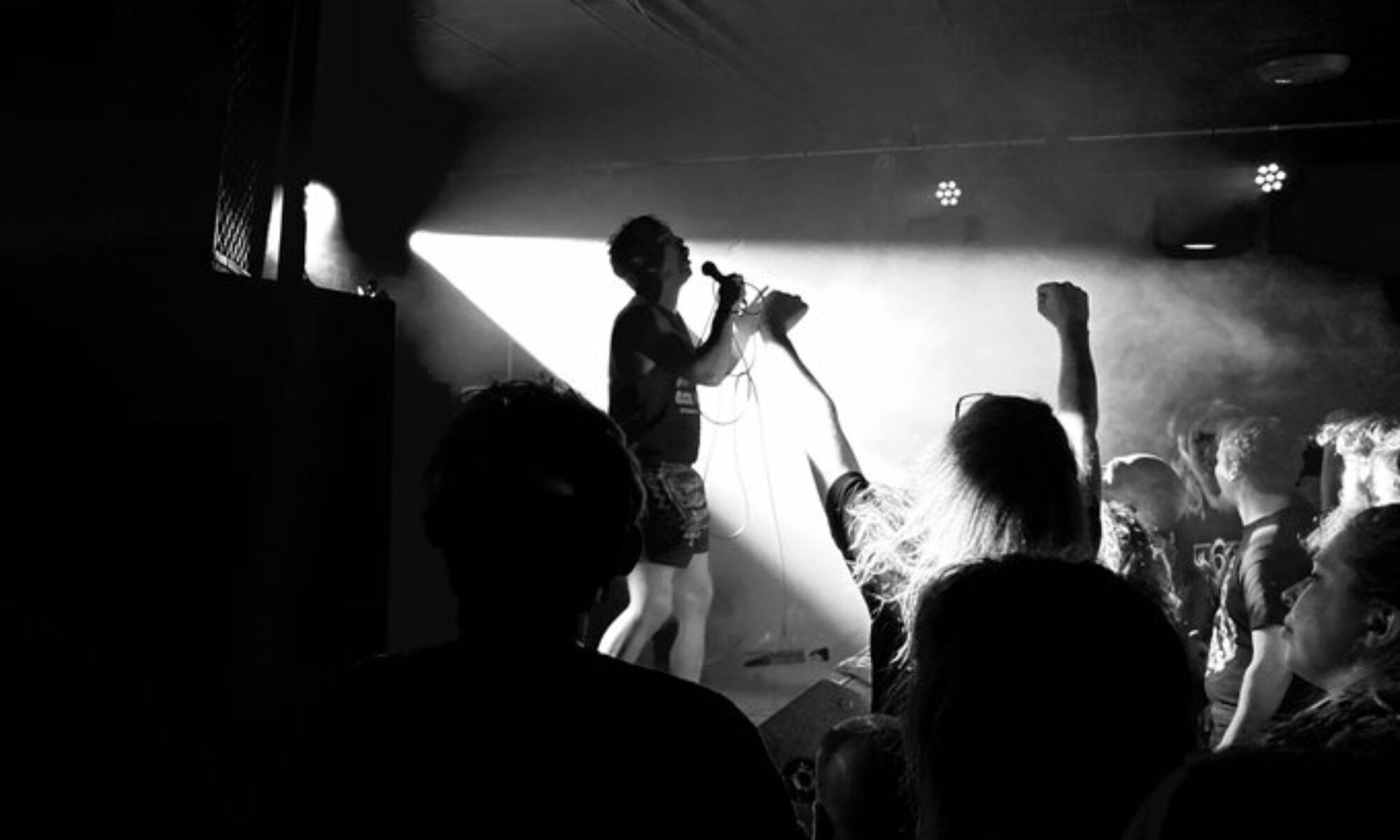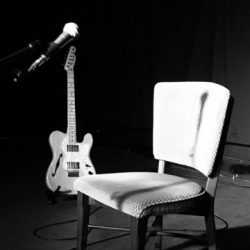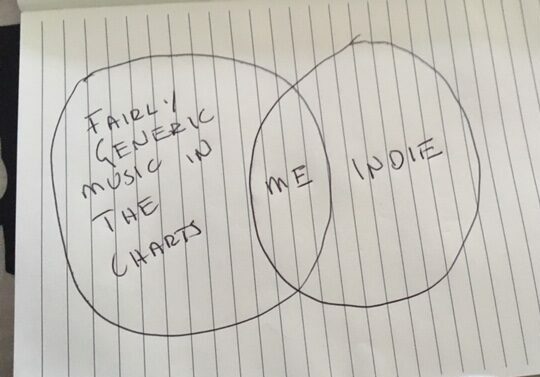Pixies (never the Pixies) are a band that I can’t seem to shake. They (along with Neil Diamond, my mum’s favourite) have been ever present in my musical life. Sometimes they dip a little off the radar but never enough so that their surfy art school anger stops beeping entirely. Lately, I’ll admit, it’s been harder to sustain. Their post-Kim material has been consistent in its disappointment (although they still rock it live) but I can’t imagine a day when I’ll ever say I’m over them. When I was starting my ascent on Mount Indie there was some degree of Venn diagramming at work. On one side was ‘fairly generic music in the charts’ and this covered pretty much everything from hair metal to daisy age via Fine Young Cannibals, Soul II Soul and Transvision Vamp. This part of the diagram contains loads of good stuff but there wasn’t any determined taste or tribalism involved. The other side just said ‘indie’ and that included all the various scenes I would later claim to discern. It also contained Pixies. This name stood on its own and had no real contemporaries. I didn’t know anything about the American Underground. Sonic Youth were a noisy nightmare still to come, Tad was a word I’d use when trying to sound clever and Dinosaur Jr was that annoying little shit Gadzooky who spoilt the Godzilla cartoons on Going Live. Pixies were there because in the centre of the Venn was me. I was desperate to be cool but still liked Roy of the Rovers. I was desperate to showcase my taste but still limited in my listening and reading habits. I like to think I was buying NME every week and Select every month but, in those early transitional moments, it was Look In, Fast Forward and, of course, Smash Hits.
I know now that Smash Hits was taking the piss. I know now that there was a playfulness to their interviews and a tacit recognition that lots of the music they featured was terrible. I know that now. I didn’t then. When I was 14 it was proper actual journalism and, more importantly, it came with loads of posters. It was there, while reading the reviews in a hospital waiting room, that I encountered a paragraph reviewing Bossanova, the fourth Pixies album (if you count Come on Pilgrim which I very much do, thank you very much.). It’s weird, my memory of reading that particular issue is that this review stood out from all of the technicolour pop stuff and that most of the magazine was taken up by whatever the latest SAW nonsense was. This, however, is only partly true. I discovered this when chancing (aka searching for several hours) upon a scanned copy on the Internet. The other reviews that week, for example, include Ice Cube, Smith and Mighty, and The Farm. But this is offset somewhat by the main review feature being given to Ramsey Street’s dungaree brandishing, ex-con, sweetie-pie Craig McClachlan. The rest of the magazine gives pretty much equal space to Bobby Gillespie (‘At Home With’), MC Hammer (‘24½ interesting facts’) and Betty Boo (‘lost in space’). I liked all of these artists at one time or another and I suppose that is why I bought the mag for so long. Turns out it was better than I remember, and this is pretty much the opposite of all of my other nostalgic obsessions. Like me, in 1990 it seems like Smash Hits sat in the middle of the Venn diagram. When the 80s gave way to the 90s and the underground started to make noise, this was reflected in this magazine, on Top of the Tops and in my small but perfectly formed cassette collection.
Anyway, to the review in question and how it started me on my 4AD journey. It’s weird. You would assume that there was some magical incantation there that suggested a sonic space where sorcery happened and where lyrical genius bit your face before kissing it better. For a review that changed my life, it’s actually pretty rubbish. The epic grandeur of Velouria is described as ‘having a nice tune without sounding poppy’. The rest of the songs are, ‘more spikey, and have an energising sort of boisterous drive’. Lyrics are ‘pretty weird’ but, never fear, ‘like Depeche Mode, the whole thing really sneaks up on you’.
But this review worked. The next chance I had, I went into Woolworths (miss you!) and spent my paper round money on Bossanova. This small brown rectangle was my first true indie album. It was also, unknowingly at the time, my first 4AD product. The cover, even at tape size, is fucking magic. The Saturn style logo sits in the middle of a red brown palate. Strange and kitsch alien forms encased in 60s futurist circles sit in the four corners. Interviewed by Murray Stassen, Vaughan Oliver explains that the ‘B-Movie’ feel came out of conversations with Pixies head honcho Black Francis (Charles Thompson to his mum) around ‘lyrics with UFO references’. The colour scheme, it turns out, was a happy accident. Photographer Simon Larbelestier accidentally flooded the images with red light. I’ve been listening to this album for 30 years and staring at that sleeve the whole time but writing this and reading that interview are the first time I’ve actually seen the process and details. I’d never really noticed the plastic rods before or made the connection to the band’s sci-fi schlock. But, simultaneously, I’ve always known all of this. It’d gone in by osmosis. This is the strange hold these sleeves have over me and why I would never go on the radio to talk about them. They speak to the cultural quagmire that exists beneath any way of articulating it in coherent language. The references to film, visual culture, high- and low art, and literature are, to quote Douglas Adams, ‘the whole sort of general mish mash’ of my life. They are the contents of my plastic bag. They are the stuff that pours out in my dreams (which have become paralyzingly weird during lockdown). The sleeves speak to the liminal space between my conscious and unconscious selves. And what better one to start with for a 14-year-old idiot who loved space stories, spaceships and all other spacey things? The sleeve celebrates this type of storytelling but also speaks more broadly to unknowable otherness and mystery. It asks us to engage with strangeness and accept the complexities of desire, knowledge and movement.
I mean, imagine saying all that on a radio show. Not a chance.
My Pixies love has waxed, waned and carried on spinning much like that lovely red brown planet. Once they split and I morphed from indie kid to techno head, they featured less and less in my daily life. They never really went away though and became the sort of band that I’d suddenly want to listen to in a, ‘ooh, I haven’t heard that for ages’ sort of way. I’d be sitting with my friends at university and, among all the terrible Goa trance we’d somehow got into, I’d put on Doolittle and discover that we all loved it. Someone would grab a guitar and try to play Here Comes Your Man (I hated this though. When it comes to earnest guitar strumming, I am firmly in the John Belushi camp). But it was all nostalgic. Even in our early twenties we were looking back and reconstructing ourselves. At university this process is always magnified. You are always reinventing yourself for a new gang and being a big old Pixies fan was certainly a better look than the Wendy James fixation that had taken up most of 1989.
All of this nostalgia for teenage music came to fruition in the noughties. It seems odd to say this now, but canonical bands getting back together after a horrible split was pretty rare before the 21st century. Pixies had a split more horrible than many. No, band reunions were reserved for the big boomer acts ready to sell out Wembley and flog a billion t-shirts. Someone as cool and angsty as Pixies would never do it. Wait…what? Yep, as we all know now, they did just that in 2004. They got back together and toured all of the old numbers across the US and then across Europe. They played a gazillion festival dates (including the execrable, litter-strewn extravaganza that was V2005, where I saw them) and then toured some more. They did a Doolittle 20th anniversary tour (I saw them at Brixton Academy about 20 feet from Kim Deal. Magnificent.) Then Kim left. She was replaced by another Kim (RIP) and then by a Paz. She was always going to leave. The tensions in the band as they toured are brilliantly captured in Steven Cantor and Matthew Galkin’s documentary QuietLoudQuiet. Kim’s addiction problems, the heart-wrenching grief drummer David Lovering feels for the loss of his Dad, Joey’s ambivalence and Charles’ barely contained rage are a pretty toxic cocktail. On stage it means they smash it night after night (apart from David’s occasional on stage drum melt down) but offstage they can barely speak to one another. Kim and Charles are particularly frosty. When Kim has to soak her blistered hand in ice after their opening gig, Charles’ ‘oh, Kim’ mumbled in sympathy carries a clear ‘Kim, you are a fuckwit’ subtext.
So, she left. Went back to Dayton to be with her ailing mum and her twin sister Kelley. Like lots of musos my age, I suffer from Kim Deal syndrome. She is the coolest rock star of all time. A brilliant musician, funny as fuck, the best songwriter I can think of. She could drink us all under the table. What’s not to fall in love with? Other indie stars come and go, but Kim will always be the coolest. So, when she left Pixies it was no Kim, no Deal for me. They would never be the same without her. It would just be Charles’ band now. The tension between the two of them and the sonic juxtaposition of their voices (you don’t get that sort of phrase in Smash Hits do you?) was what made them so fascinating. And so it proved. The material that Pixies have written and recorded since is pretty mediocre. They are still worth a watch live as I can attest to after a very pissed night at Blue Dot festival in 2017 during which they played THIRTY songs. But the new albums? Nah. The Breeders on the other hand…


